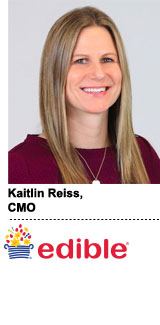
Edible Arrangements is best known for its fresh fruit and chocolate arrangements, many of which are gifted at the last minute for holidays or anniversaries.
Although 65% of Edible Arrangement’s business comes from ecommerce, the brand wants to drive visits – particularly from repeat customers – into its 1,200 local store franchises.
“No one’s going to buy an arrangement at a $60-$70 price point for themselves, but they may want to enjoy that same fresh fruit in a different format like a parfait,” said Edible Arrangements’ CMO, Kaitlin Reiss. “In the day and age of Uber Eats and Grubhub, people want delivery and they want it now, so we’re trying to develop new ways to experience Edible Arrangements.”
Consumers are conditioned to expect same-day delivery, thanks to services like Amazon Prime. Edible Arrangements has supported same-day delivery for a while.
But for a digital and in-store strategy to succeed, the channels need to coexist.
“We rely heavily on our storefronts to fulfill our online deliveries, which is the main driver of the digital growth we’ve seen,” Reiss said. “Consumers are so last-minute that having a website presence with seamless checkout makes it easier for consumers to find an arrangement, and a local store that can fulfill it.”
Reiss spoke with AdExchanger.
AdExchanger: Where are you investing most with marketing?
KAITLIN REISS: Our digital marketing efforts over the next year will revolve around driving more people into our stores. We’re not necessarily trying to change user behavior because, at the end of the day, we do most of our business through gifting.
But we’re [figuring out how to] expand our product offering from arrangements and fresh fruit to more treats people love.
There’s a lack of awareness about our stores because most of what they do is fulfillment.
What are your biggest challenges, since you’re mostly a gifting business?
A lot of retailers are pivoting to ecommerce. We’re using our ecommerce and digital presence to drive people into stores, so we’re essentially doing the opposite.
Believe it or not, marketing during a holiday time is much easier because many more people are in the mindset of buying for someone at this time of year. It’s much easier as a marketer during a gifting time period as opposed to everyday purchases, when I don’t know if your significant other’s birthday is coming up.
There are so many questions about the gifter and their relationship to the receiver, so we rely a lot on our existing data. Personalization is key.
What signals help determine a gifter’s intent?
It’s important to know whether you’ve bought in the past. Leveraging existing data is really important so we’re not just batching and blasting year round. New customer acquisition is difficult in the gifting business, but there are cues you can take from social media.
We [can’t] target someone’s Facebook friends, so one strategy is that we target fans who have birthdays with a personalized edible, a fruit-shaped number. That led to the person either sharing the post, saying thank you or tagging their friends. So campaigns like that, even if they’re targeted more toward the individual, provide us with more data.
What do you prioritize in new customer acquisition?
We are doing a lot of lookalike modeling. We’re looking at how we can best talk to [potential] customers about our product offering. Is it a price point strategy? Is it a holiday strategy or the fact that we have same-day delivery? And what’s the share of wallet from competitors in the gifting industry so we can we talk more about our value proposition?
How do you use paid media?
There is always some digital component. Even in TV, people are going to Google and typing in “Edible Arrangements,” or scrolling through Facebook, so we have to make sure we’re targeting people who are watching the commercial at that time.
This year, I want to get an attribution study across all channels. We didn’t have any understanding whether people who were watching our TV commercials were coming to our site. We’re using iSpot.tv to better understand not only whether this person come to our site, but we can see if someone turned off the television at a certain spot or only watched 25% of the commercial.
Before using advanced attribution tools, [we relied] on Google ad impressions and direct TV traffic to make those assumptions.
What tech will you invest in?
Programmatic geotargeting is something we’re definitely thinking more about. We’ve already done geofencing with Google for all of our locations.
Another thing is we don’t have a voice strategy right now. It’s not a retail play yet, but it will be. Mobile exploded overnight and I believe voice is next.
This post was syndicated from Ad Exchanger.

More Stories
Go Media becomes Toitū net carbonzero certified
Under the Hood of Tesla’s Fleeting Foray Into Advertising
The Fin Tech Ad Tech Boom; Temu Tops Meta’s Charts (But At What Cost?)